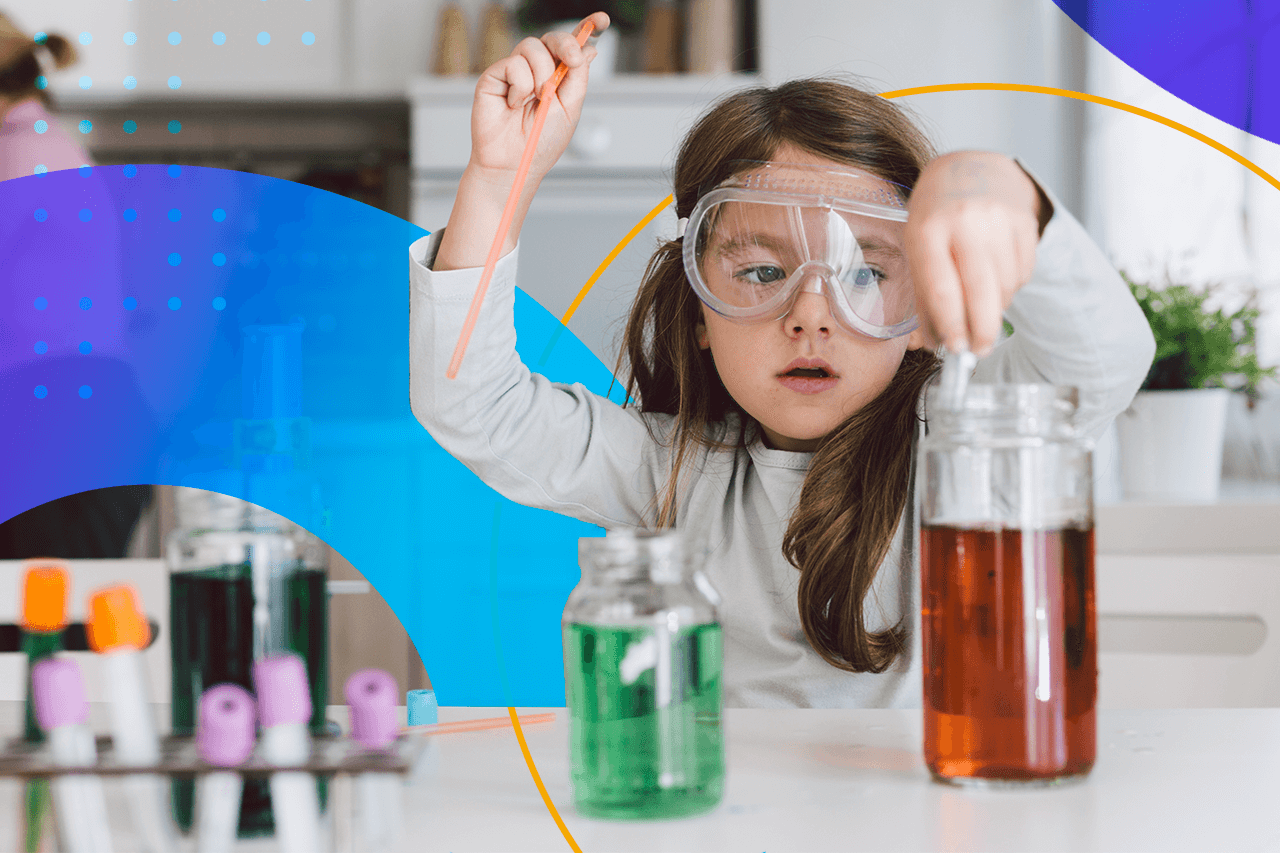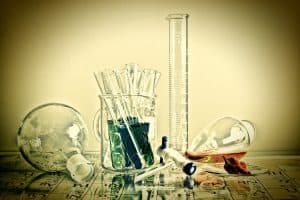
10 At-Home Chemistry Experiments Kids Will Love
September 1, 2020 - Emily Newton
Revolutionized is reader-supported. When you buy through links on our site, we may earn an affiliate commission. Learn more here.
Everyone might be home for summer vacation, but that doesn’t mean we can’t keep learning. Chemistry experiments you can do at home are a fantastic way to keep kids engaged and interested while preventing the summer slide. Here are 10 at-home chemistry experiments kids will love:
1. Bouncy Eggs
What happens to a base when you introduce it to an acid? That is precisely what this experiment helps you discover — and the result is amazing. All you need is a bottle of white vinegar, a large glass and an egg. The steps are as follows:
- Place the raw egg gently in the bottom of your glass.
- Cover the egg entirely with white vinegar.
- Wait for 2-3 days.
- Remove the egg from the vinegar and gently rinse it with water.
What you’re left with is a raw egg contained within its membrane. It’s squishy and will even bounce a little if you drop it — carefully! — on a tabletop. Why? The shell is made from calcium carbonate — a base. When you mix it with white vinegar, also known as acetic acid, the acid eats away at the shell, eventually dissolving it completely. The egg stays intact because of the membrane that surrounds its interior.
2. Leaf Chromatography
The weather is warm, making the atmosphere perfect for going nature walks and spending time in the wilderness. It’s also the ideal time to dabble in chromatography. Scientists define chromatography as the separation of a mixture by passing it through a solution or suspension. In this case, you can collect leaves on your walk and find out if their chemical imprint matches the color they display. All you need is some small jars, warm water, rubbing alcohol, coffee filters and, of course, the leaves you collected on your hike. Here are the steps:
- Collect different types of leaves and tear them into small pieces.
- Put each leaf in a separate jar and cover it with rubbing alcohol.
- Grind the leaves up with the blunt end of a spoon.
- Put the lids on the jars and put them in a hot water bath. Let them sit for 30 minutes.
- Add a strip of a coffee filter and let the jar sit for another 30 minutes.
The coffee filter should start picking up color. Compare it to the color of the original leaf. Is it the same color, or did it change?
3. Exploding Sidewalk Chalk
Sidewalk chalk is a fun toy for spending an afternoon outside. Know how you can make it more exciting? Make it explode. Don’t worry — there’s nothing dangerous about this chemistry experiment. All you need is vinegar, plastic sandwich bags, food coloring, cornstarch and baking soda. Here’s how to perform this experiment:
- Mix 1 cup (0.24 liters) of vinegar with 1 cup (0.24 liters) of cornstarch in your sandwich bags.
- Add several drops of your chosen food coloring, and you’ve got homemade liquid sidewalk chalk. You can draw and paint with this, but we’re here to make things explode.
- Make a baking soda bomb — wrap a couple of tablespoons of baking soda in a single square of toilet paper.
- When you’re ready to paint the world, toss a baking soda bomb into your plastic bag, seal it and shake well.
- Set it down and wait for the chemical reaction to create an explosion of color.
The vinegar in your sandwich bags reacts with the baking soda, generating carbon dioxide. This gas fills the sealed bag, eventually causing it to pop. It’s the same reaction you’ll see in a pumpkin-cano or baking soda volcano.
4. Growing Crystals
Crystallization might seem like an experiment for a geologist, but you can turn it into a chemistry lesson as well. All you need is some construction paper and substances that crystallize when they dry out, like salt, sugar, Epsom salts or borax. Follow these steps for this experiment:
- Mix a quarter cup (0.06 liters) of your crystal material with half a cup (0.12 liters) of boiling water.
- Add food coloring if you want to make colored crystals.
- Pour the liquid into a shallow dish or over a sponge.
That’s it. As the liquid cools, it will start forming crystals. Epsom salts will start forming thin crystals within 30 minutes as the liquid returns to room temperature.
5. Oobleck!
This is probably the easiest chemistry experiment for kids to play with — and possibly one of the most fun. It lets you play with the idea of non-Newtonian fluids. These fluids are solid when subjected to kinetic energy and liquid in every other situation. All you need is water and cornstarch. To do this experiment, follow this single step:
- Mix equal parts water and cornstarch.
That’s it — that’s the experiment. Now you get to play. When you run your fingers slowly through the oobleck, it feels like a thick liquid, but if you move too quickly, it solidifies. Get messy and see what you can do with it. If you make enough, you can even run on water!
6. Color-Changing Cabbage
You might not like the taste of cabbage, but you can take it and turn it into a fun chemistry experiment that plays with pH. All you need is some water, red cabbage and coffee filters. Here are the steps:
- Blend three or four large cabbage leaves with a half-full blender carafe of water.
- Strain out the cabbage pieces, and you’ll be left with a bright purple liquid.
- Soak small strips of coffee filter in the cabbage water and set them aside to dry.
- Pour a small amount of your cabbage water into two separate glasses.
- Pour an acid like lemon juice into one and a base like baking soda into the other.
The cabbage water reacts to the pH of the items you introduce to it. Acids change it from purple to red, and bases will turn it from purple to green. Now you can use those coffee filter strips as a DIY litmus test to check the pH of different liquids around your home.
7. Magnetic Slime
Slime is one of the most popular science experiments, but after you’ve made the same old borax slime multiple times, it gets kind of boring. Why not change things up by making some magnetic slime? You need most of the same ingredients you might use for regular slime, like liquid starch and white glue, with one addition — iron oxide powder. Make your magnetic slime by following these steps:
- Mix 1 tablespoon of iron oxide powder with 2 tablespoons of liquid starch.
- Add 2 tablespoons of white glue and stir until everything is completely mixed.
- Put on a pair of gloves and knead the slime until everything gets fully incorporated. It will start to dry out and, eventually, you’ll be able to manipulate it with your bare hands.
Now, this is where things get fun. Get some magnets and see how the magnetic slime reacts. It doesn’t move fast, but eventually, it will creep toward the magnets and envelop them.
8. Rainbow in a Glass
You might think layered drinks are reserved for fancy bars, but they can also be a fun way to explore chemistry and fluid density. You’ll need a large clear container, a variety of different liquids and — if you want to create a rainbow — some food coloring. We like to use corn syrup, dish soap, vodka and canola oil, but you can experiment to see what will float or sink. Try the experiment by following these steps:
- Start by pouring your densest liquid at the bottom of your container. In our example, that would be the corn syrup.
- Layer each liquid gently on top of the one before it.
Try not to let your liquids mix. The easiest way to do this is to tilt your container and pour down the side of the glass. You can also pour over the back of a spoon like you would if you were layering a drink. Experiment with different liquids to see what layers well and what mixes. You can create a custom rainbow by mixing food coloring with different liquids.
9. Penny Cleaning
Pennies might not have the copper content they once did, but their thin copper coating can still generate a patina of tarnish in addition to the dirt and grime they accumulate over time. Play with the acids in your kitchen — vinegar, lemon juice, salsa, tomatoes or anything else that might contain acid — to clean your coins. Here are the steps:
- Collect a bunch of tarnished pennies — the dirtier, the better.
- Put a few pennies in each of your acids and let them soak for 5-10 minutes.
- Wash the pennies off with soap and water.
Which pennies are the cleanest? Which acid works the best? Acids make effective cleaners because they cut through the oxidation and expose the clean copper beneath. If you have any really dirty pennies, this is a fantastic way to introduce kids to the concept of acids.
10. DIY Lava Lamps
It doesn’t matter how old you are — lava lamps are cool. Of course, the classic versions tended to get hot and presented a burn risk, so they’re not terribly kid-friendly. Why not make a kid-safe one while you’re exploring chemistry? All you need is a clear glass, water, food coloring, oil and an Alka-Seltzer tablet. Try it out and make your own lava lamp:
- Fill your container about two-thirds of the way with cooking oil.
- Add a small amount of water — it will settle to the bottom.
- Add several drops of food coloring. It will sink to the bottom with the water.
- Drop an Alka-Seltzer tablet in your container and watch the fun begin.
When it reacts with the water, the tablet releases carbon dioxide bubbles. They rise up through the oil, taking water and food coloring with them, creating a lava lamp-esque reaction that your kids will want to try again and again.
Which One Do You Want to Try First?
Which of these fun chemistry experiments is first on your list of things to try? You may already have many of the ingredients lying around your house!
Revolutionized is reader-supported. When you buy through links on our site, we may earn an affiliate commission. Learn more here.
Author
Emily Newton
Emily Newton is a technology and industrial journalist and the Editor in Chief of Revolutionized. She manages the sites publishing schedule, SEO optimization and content strategy. Emily enjoys writing and researching articles about how technology is changing every industry. When she isn't working, Emily enjoys playing video games or curling up with a good book.






